
Station Name: CORNHOLME[Source: Alan Young]
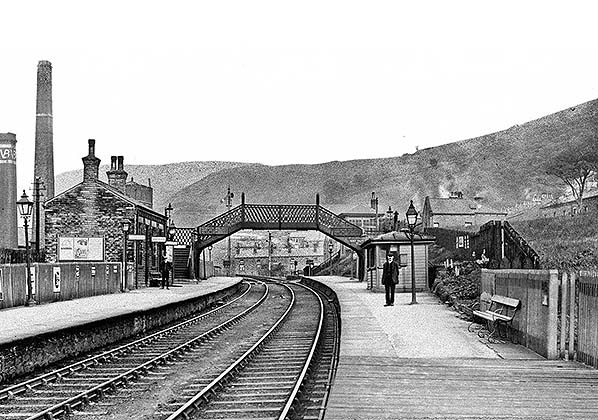 Cornholme station looking north-west from the up (Todmorden-bound) platform c1905. The sandstone station building, an unpretentious, tall single-storey affair is on the down platform, whilst the enclosed timber waiting shelter on the up platform is even more modest. Unlike its neighbours at Portsmouth, Holme and Towneley, Cornholme station possessed a footbridge to link its platforms. The signal box, a Saxby & Farmer Type 9, is seen on the slope of the cutting at the far end of the up platform; it opened before the station in 1877 and outlasted the station, closing in 1969. The chimneys of Vale cotton mill can be seen far left.
Photo from John Mann collection  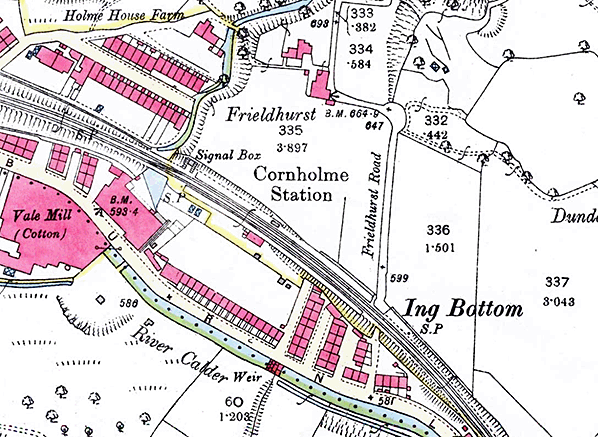 1894 1: 2,500 OS map.Cornholme station was built only a mile east of Portsmouth station, some 30 years after the Copy Pit line opened, to serve the expanding population. The station possesses two facing platforms, connected by a footbridge. The main building, with pink tinting, is on the down (south-west) platform and the up platform waiting shelter stands opposite it. The signal box is at the north-west end of the station, on the up side, set back on the slope of the cutting. No goods facilities are provided. Some of the houses close to the station are of back-to-back design, as on Station Road and Thomas Street. The River Calder emerges from its culvert beneath Vale Mill. 1894 1: 2,500 OS map.Cornholme station was built only a mile east of Portsmouth station, some 30 years after the Copy Pit line opened, to serve the expanding population. The station possesses two facing platforms, connected by a footbridge. The main building, with pink tinting, is on the down (south-west) platform and the up platform waiting shelter stands opposite it. The signal box is at the north-west end of the station, on the up side, set back on the slope of the cutting. No goods facilities are provided. Some of the houses close to the station are of back-to-back design, as on Station Road and Thomas Street. The River Calder emerges from its culvert beneath Vale Mill.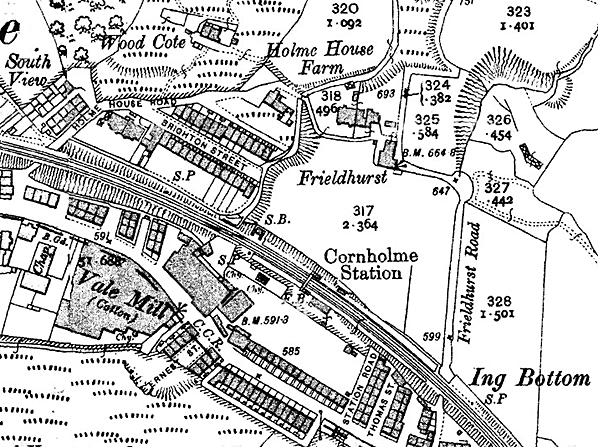
1907 1: 2,500 OS map. For three miles beyond Todmorden town centre there is almost continuous urban and industrial development in the deep, narrow valley of the (Yorkshire) River Calder. Cornholme station was built only a mile east of Portsmouth station, some 30 years after the Copy Pit line opened, to serve the expanding population. Cornholme station has two facing platforms, connected by a footbridge. The main building is on the down (south-west) platform and the up platform waiting shelter stands opposite it. The signal box is at the north-west end of the station, on the up side. No goods facilities are provided, and neither is there any siding to serve the nearby cotton mill. Some of the houses close to the station are of back-to-back design, as on Station Road and Thomas Street. The river emerges from a culvert close to the junction of the main Burnley Road and Station Road.
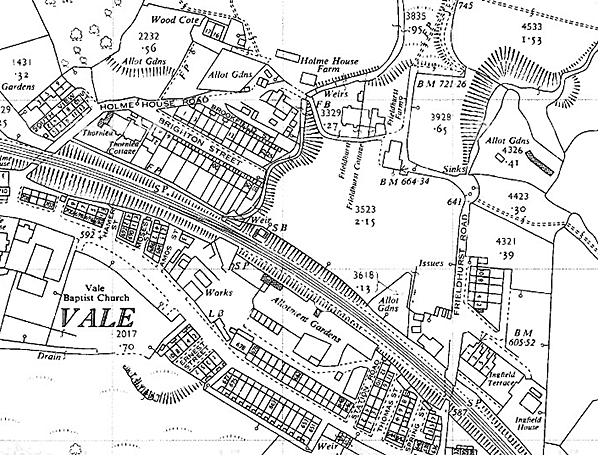 1961 1: 2,500 OS map. Cornholme station closed in 1938 and has been removed; only the name of Station Road is a reminder that there was ever a station here. The signal box (S B) has
outlived the station. 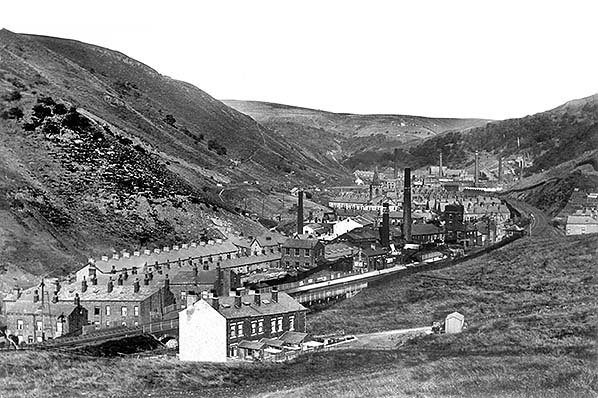
Looking west towards Cornholme station from the valley side slope c1905. It can be seen that the platforms begin to the left on an embankment and end in a cutting. The main building is on the down (Burnley-bound) platform and the signal box on the opposite side of the tracks is visible further to the right. Vale Mill is just behind the station. The terraced housing and industrial establishments with their chimneystacks are confined to the floor of the Calder valley; the steep slopes and moorland in the background are shunned by settlement. The far end of the built up area is known as Portsmouth, the location of the next station on the way to Burnley.
Looking west towards Cornholme station in or before 1906. Brighton Terrace is seen on the left. From this viewpoint the signal box is the most prominent feature of the station, constructed in 1877 in an elevated position on the slope of the cutting. Beyond it, far right, the station footbridge and the waiting shed on the up platform are visible.
Copyright photo from John Alsop collection 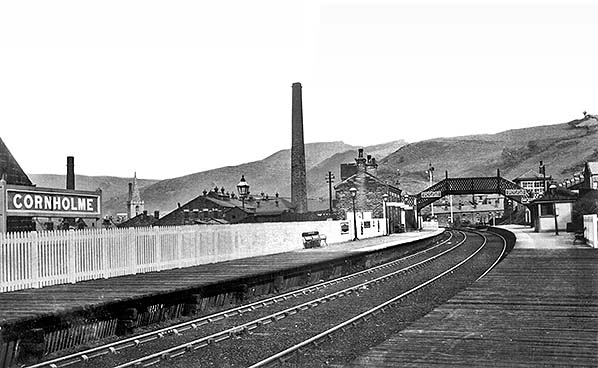
Cornholme station, looking west c1910 from the up (Todmorden-bound) platform. The near ends of both platforms are on an embankment and are constructed of timber, perhaps to reduce their weight. The main building, constructed of sandstone and under a pitched roof, is on the down platform, whilst a smaller timber-built waiting shed with a hipped roof faces it on the up platform. Beyond the footbridge the signal box can be seen in an elevated position behind the up platform. The LYR running-in nameboard is suitably prominent on the down platform. The station’s surroundings are typical of much of the central Pennines, with housing and industry tightly packed into the valley floor in sharp contrast to the bleak, sparsely populated moors on either side.
Photo from John Mann and Pennine Horizons Digital Archive collections 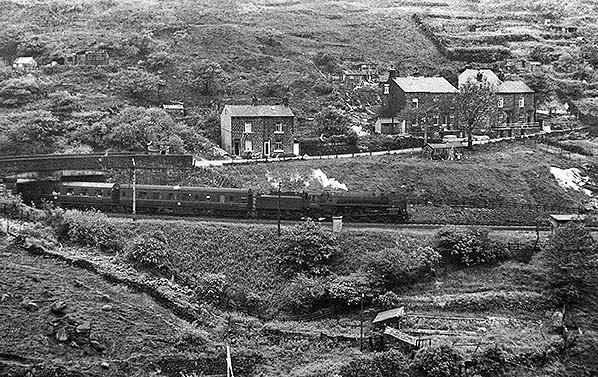 On 10 June 1966 No.70003 ‘John Bunyan’ is hauling a Fleetwood to York party special near Cornholme. The Britannia class 4-6-2, designed at BR Derby works was built at Crewe works in March 1951. She was withdrawn from 68A, Carlisle Kingmoor shed, on 25 March 1967 and cut up by Campbells of Airdrie in November of that year.
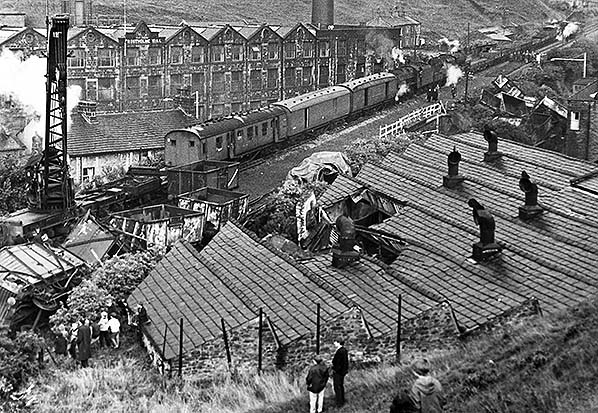
On the night of 15-16 August 1967 an accident occurred at Cornholme. A freight train of 36 loaded vans and empty mineral wagons, headed by Type 4 (later Class 40) diesel D398, travelling from Lostock Hall to Healey Mills collided with the Copy Pit 8F 2-8-0 banker at 60 to 70 mph, pushing the banker about half a mile down the 1 in 80 gradient. The driver of the diesel was killed and the freight train was derailed; wreckage was strewn for over a mile and some of the wagons tumbled down the embankment, one landing in the kitchen of a lineside house. It seems that the diesel driver had recently consumed the equivalent of five to six pints of beer and passed six signals at danger while ignoring line speed limits. On 16 August the Lostock Hall crane is in attendance.
Photo
by Ian G Holt
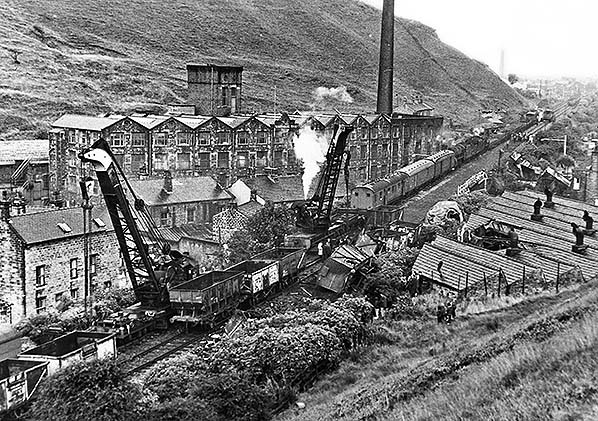
At Cornholme on 16 August 1967 the Newton Heath crane has joined the Lostock Hall crane in sorting out the wreckage caused by a runaway eastbound freight train.
Photo by Ian G Holt 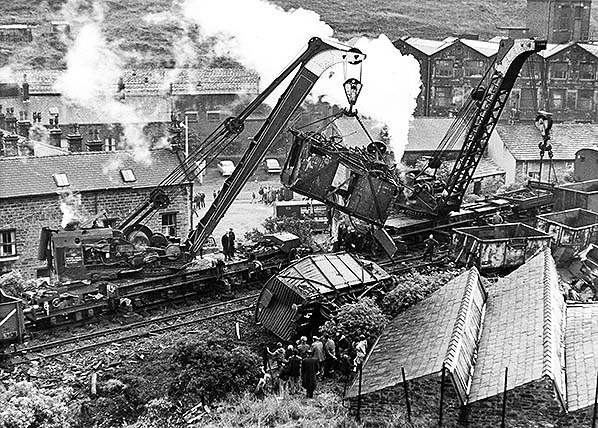
At Cornholme the cranes from Lostock Hall and Newton Heath sheds are hard at work clearing wreckage on 16 August 1967 which resulted from the collision of an eastbound freight train with the Copy Pit banking engine.
Photo by Ian G Holt 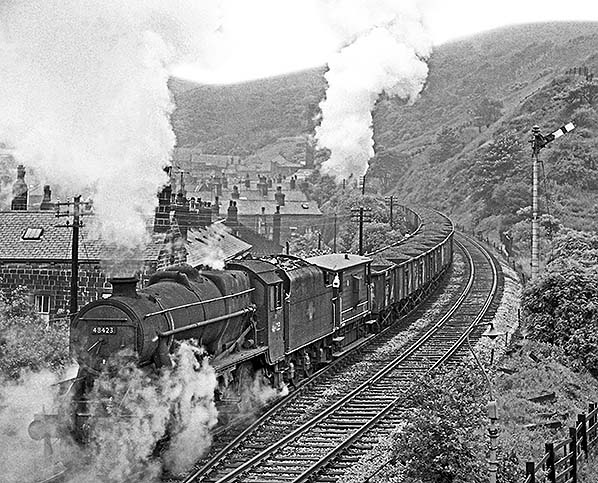 On 23 June 1968 a westbound coal train is photographed near Cornholme. The loco No.48423 is banking the train tender-first, as indicated on the tail lamps on the loco and on the brake van beyond it. This tender-first arrangement is unusual because of the danger of running short of boiler water with the engine tipping slightly forwards, but the 1 in 65 gradient here (the steepest on the Copy Pit route) is not steep enough to cause such a problem. The steam from the train engine is seen in the distance. No.48423 is a Stanier-designed 8F 2-8-0 built at Swindon works and is understood to be allocated to 24B, Rose Grove shed. Steam working on British Rail ceased the following August.
Photo by Eddie Bobrowski 
Looking north-west at Cornholme in February 1971. The station closed to all traffic in 1938. The viewpoint is midway along the former platforms where an embankment ends and a cutting begins. The signal box used to stand on the slope of the cutting to the right, close to the more distant bush, but it closed in summer 1969 and has been swiftly removed.
Photo
by John Mann
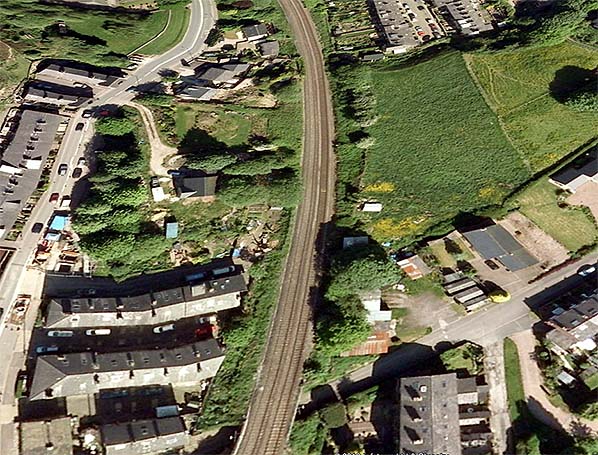
An aerial view of the site of Cornholme station which closed to all traffic in 1938 and has been comprehensively obliterated. Station Road is at the far side of the longer terrace, near the lower left-hand corner; the near side of the same back-to-back terrace is on Thomas Street. West is at the top of the image.
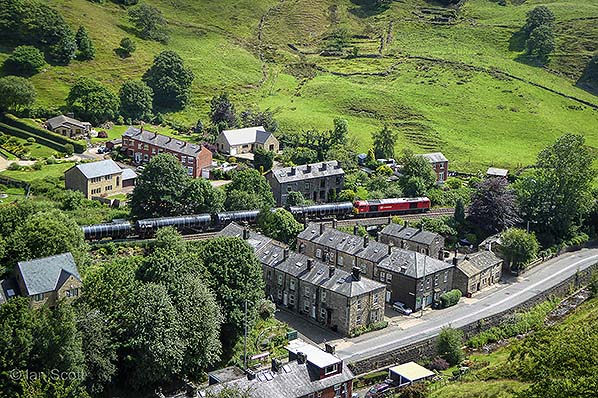
Looking north-east at Cornholme where the train is passing the site of the station. The working appears to be 6E32 Preston Docks to Lindsey discharged bitumen tanks for Total. The loco is a Class 60 Type 5, the final diesel locomotives built for BR between 1989 and 1993 by Brush Traction at Loughborough. This one is owned by DB Schenker. The picture must be prior to January 2015, as the working has since passed to Colas who use 60s purchased from DBS. The nearest street is Station Road. The terraced houses are back-to-back – a design still seen in many industrial settlements in West Yorkshire, notably in Leeds.
Copyright photo by Ian Scott from his Flickr photostream
|
 Whilst the earlier stations at Holme and Portsmouth both had timber buildings, Cornholme was provided with a stone building towards the west end of the down platform. This was an austere but lofty single-storey structure with rectangular openings and a pitched roof, in which booking and waiting facilities were accommodated. On the opposite platform was an enclosed waiting shed of timber with a hipped roof, similar in appearance to structures at Holme and Portsmouth, and probably an addition to the station in the 1890s or the following decade. Although there was a barrow crossing at the west end of the station, an iron lattice footbridge was provided to connect the two platforms. Gas lighting was installed.
Whilst the earlier stations at Holme and Portsmouth both had timber buildings, Cornholme was provided with a stone building towards the west end of the down platform. This was an austere but lofty single-storey structure with rectangular openings and a pitched roof, in which booking and waiting facilities were accommodated. On the opposite platform was an enclosed waiting shed of timber with a hipped roof, similar in appearance to structures at Holme and Portsmouth, and probably an addition to the station in the 1890s or the following decade. Although there was a barrow crossing at the west end of the station, an iron lattice footbridge was provided to connect the two platforms. Gas lighting was installed.
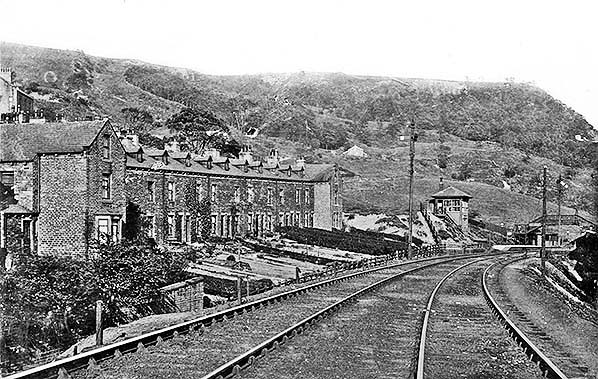

 Home Page
Home Page